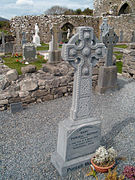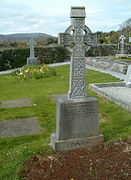Corcomroe Abbey
| Corcomroe Cistercian Abbey | |
|---|---|
 Cormcomroe Abbey |
|
| location |
County Clare |
| Coordinates: | 53 ° 7 '27 " N , 9 ° 3' 30" W |
| Serial number according to Janauschek |
512 |
| Patronage | St. Mary |
| founding year | 1195 |
| Year of dissolution / annulment |
1540 |
| Mother monastery | Inislounaght Abbey |
| Primary Abbey | Clairvaux Monastery |
|
Daughter monasteries |
Kilshane Abbey (Kilsonna) |
The Cistercian Abbey Corcomroe Abbey ( Irish Mainistir Chorca Mrua ) or "Sancta Maria de Petra Fertili", (Holy Mary of the Fertile Stones), founded around 1195 , is one of the most important places in the Burren . Its construction in what is now Bellharbour in the north of County Clare is at the end of a five-decade long activity of the order in Ireland in the 12th century and is a partially unique architecture.
history
The historical information is poor, but it is certain that a King of Thomond , either Donal Mór O'Brien († 1194 - who also founded Holy Cross Abbey ) or his son Donat founded the abbey. Monks from Inislounaght Monastery in County Tipperary were the builders. The land ownership of the Cistercian abbeys was usually based on thousands of acres of fertile land. Corcomroe is also a relatively productive place, but only in contrast to the baldness of the southern Burren. Located on the northern border of Thomond, the area was suitable to secure the north-south connection at the "Corker Pass". The abbey was not intended for the religious supply of the northern Burren, which was done by the nearby churches of Oughtmama , but rather the basis for the maintenance of an O'Brien garrison. In this respect Corcomroe can be compared to other monastic foundations of the O'Brien clan on the periphery of the kingdom, Kilcooly Abbey and the mighty Holy Cross Abbey at Thurles, both in eastern Tipperary. Corcomroe founded the subsidiary Kilshane Abbey (Kilsonna) in 1198 .
In the 13th century, Ireland, which had been divided since 1167, arose a conflict between the Anglo-Norman and the Irish Cistercian abbeys. Corcomroe, as an Irish abbey, was placed under the "Rule of Furness" in Lancashire in 1228, but three years later it was again affiliated to the Mellifont Monastery . However, it remained permanently outside the main focus of Cistercian activities on the island.
- Corcomroe Abbey and Cemetery
Two battles were fought in the abbey:
In 1267, Conor na Siudaine O'Brien, King of Thomond, was killed in the fight against Carrach O'Loughlin, a local clan leader of the Burren, and was solemnly buried in the abbey.
In 1317 a battle between the O'Briens was fought on Abbey Hill, with the participation of Normans, in which several O'Briens were killed.
An abbot of Corcomroe Monastery became Bishop of Kilmacduagh in 1418 . After the abbey was dissolved in 1540, various members of the O'Brien family ran the abbey. In 1611 Richard Harding Abbey received approximately 30 hectares of land in nearby Aughinish. In 1628 John O'Dea, an Irish monk from Salamanca, was appointed abbot.
Architecture
Cistercian abbeys follow the same plan with a cloister mostly on the south side of the church and the cloister buildings as conversions of a square courtyard. This basic plan was also adapted here, but hardly any remains of the monastery area have been preserved. The church has a roughly square choir flanked by chapels in the square transepts. According to the art historian Roger Stalley, who tried to create a chronology of the structure, the first buildings were built between 1205 and 1210. The work of local craftsmen was carried out, presumably in two phases, of completely different quality. The early, important work was done on the choir and the north transept. The main nave and the south transept were built later. These sections are made with less high quality material and less carved details. Two simple, large lancet windows adorn the west gable above the 15th century portal.
The choir
The choir is characterized by high quality. Only the roof with its herringbone or rafter decoration on the ribs is of lesser importance. The Gothic choir arch is complemented by the capitals of the finely structured limestone pillars. Lotus flowers are the timely ornament. The simple east window is typical of the architectural style transition in the early 13th century. The lancet trio is dominated by a wider central lancet. Traces of paint can be seen on the window and on the choir walls. As the O'Brien Foundation, Corcomroe has the peculiarity of a royal tomb. A resting statue in a niche in the north wall of the choir was the only royal Irish tomb image to survive (alongside those of the O'Connor kings of Connacht in Roscommon). It dates from the 14th century and shows a crowned king in a long pleated robe. Above the crypt there is a carved panel from the same century with the bas-relief of a bishop with an Irish scepter and a Romanesque crosier. Next to it is a kind of double tomb niche from the 15th century. In the southern wall of the choir are the double-arched sediles . Its two niches, over which a single arch arches, were the seats of the deacons during mass.
The side chapels
The north chapel, including its capitals and the Gothic window, is architecturally superior to that on the south side. The entrance to the chapels consists of two differently decorated arches. Medieval graffiti can be found as remains in the south chapel and on the north wall of the choir. You can see a boat similar to the one on the round tower of Roscrea . According to Etienne Rynne (1932–2012), these graffiti, which can also be found in the Abbeys of Moyne and Knockmoy , date from the 16th century.
The meaning
Long narrow fields start from Corcomroe up Abbey Hill. This is where Yeats staged his game in 1919: "The Dreaming of the Bones". Today, bridal couples use the backdrop of the ruins as a background for wedding pictures. Rogers Stalley's book: "The Cistercian Monasteries of Ireland" (1987), paints a picture of Corcomroe in the national context.
literature
- Paul Gosling: The Burren in Medieval times . In: The Book of the Burren. Kinvara 1991 pp. 135-140.
- Peter Harbison : Guide to the Naional Monuments in the Republic of Ireland Gill and Macmillan, Dublin 1992 ISBN 0-7171-1956-4 p. 40
Web links
- Clare County Library: The Burren: corcomroe abbey (English description.)





